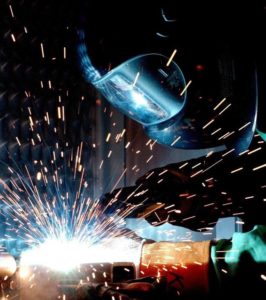Which are the Best Replacement Flints for a Welding Spark Striker
 We need to disappoint you, the replacement flints you buy to replace the worn ones in your Zippo lighter or spark welding and gas cutting torch spark striker is not flint at all – it’s just called flint because that is easier to say than its real name which is a pyrophoric alloy called ferrocerium, which consists of approx. 50% cerium, 25% lanthanum and 20% iron; the remaining 5% is magnesium, neodymium and praseodymium. Going one step further, it’s not the flint that is sparking, it’s actually iron particles burning. Upon contact with the air, a shower of tiny iron particles released by the flint, spontaneously catch on fire.
We need to disappoint you, the replacement flints you buy to replace the worn ones in your Zippo lighter or spark welding and gas cutting torch spark striker is not flint at all – it’s just called flint because that is easier to say than its real name which is a pyrophoric alloy called ferrocerium, which consists of approx. 50% cerium, 25% lanthanum and 20% iron; the remaining 5% is magnesium, neodymium and praseodymium. Going one step further, it’s not the flint that is sparking, it’s actually iron particles burning. Upon contact with the air, a shower of tiny iron particles released by the flint, spontaneously catch on fire.
The Secret of Flint and Steel for Making Fires, or in this case lighting out oxy-acetylene torch, seems obvious; striking flint with steel produces hot sparks. It has to deal with pyrophorics. Pyrophorics are substances that spontaneously ignite below room temperature, which is about 70°F (21°C). These substances will simply catch on fire of their own accord without you having to do anything such as light it with a flame aka autoignition. What many people do not realize is that iron is a pyrophoric material. In the presence of oxygen, iron catches on fire automatically. It just starts burning immediately upon contact with the oxygen in the air, in other words, it starts to rust. The act of rusting is actually an exothermic reaction called “oxidation”, which is a fancy way of saying when iron touches the oxygen in the air a reaction occurs; the iron rusts and turns into iron oxide and gives off heat in the process. In other words, it burns. Iron + Oxygen = Rust + Heat Rusting (oxidizing) is the exact same thing as burning, but unlike a campfire usually you will hardly notice it. Because of the relatively size of a typical iron object, the heat it gives off as it rusts dissipates too quickly for the heat to accumulate and be of much use. While holding an ordinary iron object you are unlikely to feel any heat as it rusts because the heat is absorbed by its surroundings as fast as the oxidation process produces it. However if you can increase the rate of oxidation you can cause the iron to spontaneously give off a large amount of heat very quickly. Small Particles Have Larger Surface Area. When a tiny particle of fresh iron is broken off from the main mass, the surface area of the particle is very large in comparison to its total size and weight. Upon contact with oxygen in the air, the tiny iron particle spontaneously ignites and glows red hot. To increase the rate of oxidization of iron give a fresh un-oxidized piece of iron more surface area in contact with the air. More oxygen touching more iron will cause more oxidation which will give off more heat in a given amount of time. Increased oxidation can be accomplished by breaking off smaller particles of iron from a bigger piece. The smaller the iron particle is, the greater its surface area compared to its total size. This is the secret to using flint and steel to start a fire or light a torch. Some of the very best flints are Tech Team’s #760, #761, #832, and #833 https://techteamproducts.com/product/triangle-flint-refill-3-pieces-00833/ https://techteamproducts.com/product/flint-replacement-set-10-pieces/ available on Amazon https://www.amazon.com/dp/B08B45K85F?ref=myi_title_dp https://www.amazon.com/dp/B08B47YPDK?ref=myi_title_dp To get more information you can do a hey Alexa or hey Siri Google search or watch the you tube videos https://youtu.be/RF7qO66T8VY https://youtu.be/mejm4tMTAbI .
A metal grinder on a piece of iron gives thousands of glowing hot sparks as it removes tiny bits of fresh iron off the chunk of iron being worked on. These tiny bits of iron are spontaneously catching on fire as they are exposed to the oxygen in the air. If you can create a small enough particle of fresh iron, upon contact with oxygen in the air the iron particles increased surface area will oxidize faster than it can dissipate the heat formed during the reaction. The result: the particle of iron spontaneously becomes so hot that it glows as it oxidizes and can be used to light a welding or cutting torch. Basically process of using a flint and steel to start a fire works like this. Take a piece of high carbon steel, which is about 98% iron and 2% carbo and a piece of flint or other hard sharp object such as quartz and strike (hence the term striker) a sharp edge of the flint a glancing blow against the high carbon steel. Very tiny particles of fresh iron will fly out from the steel and upon contact with oxygen in the air, the surfaces of the iron particles spontaneously ignite and give off heat as they oxidize (rust). Because the surface area of the iron particles is so large compared to their volume, the particles quickly heat up and glow red hot. They become sparks. Harder steel and sharper flints give better sparks. They are also very hot, almost 2500 degrees F.
